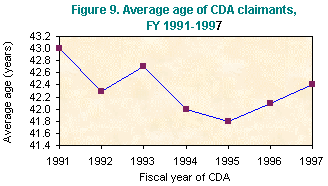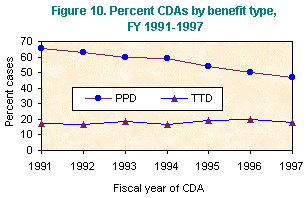
Introduction. Oregon Revised Statute 656.236 in part states: “parties to a claim, by agreement, may make such disposition of any or all matters regarding a claim, except for medical services, as the parties consider reasonable, subject to such terms and conditions as the Workers’ Compensation Board may prescribe.” This law became effective July 1, 1990.
The agreement between the worker and the insurer, called the Claim Disposition Agreement (CDA), is legal when approved by the Workers’ Compensation Board (board) in accordance with rules set by the board. Some of the salient features of the CDA process are: only accepted issues can be released; medical services are still retained for life; the worker can request the board to disapprove the CDA within 30 days (commonly referred to as the cooling-off period) of the request, unless the claimant is represented by an attorney at the time the CDA is signed, and the CDA provides for a waiver of the cooling-off period; the board order approving the CDA is not subject to review; and submission of a CDA stays all other action on that claim except for medical services.
 Requests
and orders. During the fiscal year ending June 30,
1997, the Workers’ Compensation Board received 3,304 requests
for approval of CDAs – an average of 275 a month. This is
a decrease of 14.3 percent over the previous year. During this
year 3,250 agreements were approved, nine were disapproved, and
two were withdrawn. This compares with 4,037 approvals, three
disapprovals, and seven withdrawals in FY 1996. The nine disapproved
this year were considered unreasonable as a matter of law. Figure
1 gives the distribution of requests and orders for fiscal years
1991 through 1997.
Requests
and orders. During the fiscal year ending June 30,
1997, the Workers’ Compensation Board received 3,304 requests
for approval of CDAs – an average of 275 a month. This is
a decrease of 14.3 percent over the previous year. During this
year 3,250 agreements were approved, nine were disapproved, and
two were withdrawn. This compares with 4,037 approvals, three
disapprovals, and seven withdrawals in FY 1996. The nine disapproved
this year were considered unreasonable as a matter of law. Figure
1 gives the distribution of requests and orders for fiscal years
1991 through 1997.
Characteristics of Claimants Involved
in Approved CDAs
 Age of
claimants. A little less than a third of the claimants
were between 30 and 39 years, and the large majority (93.1 percent)
were between 20 and 59 years at the time of approval of the CDA.
(See Figure 2.) Slightly less than seven percent were 60 and
over; just 0.3 percent were under 20. The average age at time
of CDA approval was 42.4 years, a little more than last year.
The frequency distribution of claimant age was very similar to
that of FY 1996.
Age of
claimants. A little less than a third of the claimants
were between 30 and 39 years, and the large majority (93.1 percent)
were between 20 and 59 years at the time of approval of the CDA.
(See Figure 2.) Slightly less than seven percent were 60 and
over; just 0.3 percent were under 20. The average age at time
of CDA approval was 42.4 years, a little more than last year.
The frequency distribution of claimant age was very similar to
that of FY 1996.
The average age at injury in these cases was 39.3 years, about two years more than the historical average age at injury for all accepted disabling claims.
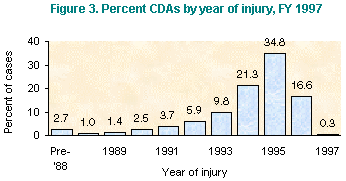 Year
of injury. For CDAs approved in FY 1997, 88.4 percent
of the injuries had occurred in the five-year period beginning
with calendar year 1992. The corresponding proportion last year
was 86.7 percent. The year of injury with the highest percent
of the approved CDAs (34.8 percent) was 1995. In cases with more
recent injuries, 16.6 percent had a 1996 date of injury and 0.3
percent (11 cases) had a 1997 injury. (See Figure 3.)
Year
of injury. For CDAs approved in FY 1997, 88.4 percent
of the injuries had occurred in the five-year period beginning
with calendar year 1992. The corresponding proportion last year
was 86.7 percent. The year of injury with the highest percent
of the approved CDAs (34.8 percent) was 1995. In cases with more
recent injuries, 16.6 percent had a 1996 date of injury and 0.3
percent (11 cases) had a 1997 injury. (See Figure 3.)
Award type. Once a claimant with an accepted claim becomes medically stationary, the claim is closed and evaluated for permanent disability. The disability level such as Permanent Partial Disability (PPD) or Permanent Total Disability (PTD) is determined at time of closure. Of the approved CDAs, 33.7 percent were on claims that had never been closed or had been closed without an award, up from 29.4 percent last year.
An award had already been made in 66.3 percent of the claims resolved by a CDA, compared to 70.6 percent last year: PPD in 47.2 percent, TTD by itself in 18.2 percent, PTD in 0.7 percent; 0.2 percent involved fatalities. (TTD may also have been awarded in those cases with a PPD or a PTD award.) This distribution is similar to last year’s except that cases with PPD and TTD dropped nearly three and one percentage points respectively with a corresponding increase in open or no-award claims.
Litigation. Seventy-one percent of the CDAs had previous or current litigation. Some 850 claims had pending litigation at the time of filing of the CDA, 91.9 percent of which were pending at Hearings Division.
Body part. As expected, the back was the body part most frequently injured in these CDAs (29.6 percent). Injuries or illnesses involving other unscheduled body parts accounted for 40.6 percent of the CDAs, while 29.8 percent dealt with scheduled body parts (extremities such as arms and legs). This is similar to the FY 1996 distribution.
Historically, the back accounted for about 27.5 percent of the accepted disabling claims, and scheduled body parts for about 44 percent.
Insurer. Over one half (51.6 percent) of the claims involving CDAs were insured by private insurers; 32.5 percent had the SAIF Corporation as the insurer, and self-insured employers accounted for 14.9 percent of the cases; for FY 1996, the respective percentages were 51.2 percent, 32.6 percent and 15.0 percent. Non-complying employers were involved in yet another 1.0 percent in FY 1997. For calendar years 1993 through 1996, the average share of accepted disabling claims for SAIF Corporation, private insurers, and self-insured employers was 30.4 percent, 49.0 percent, and 20.0 percent respectively. (See Figure 4.) Self-insured employers’ use of CDAs for release of claims is significantly less than SAIF Corporation’s or private insurers’.
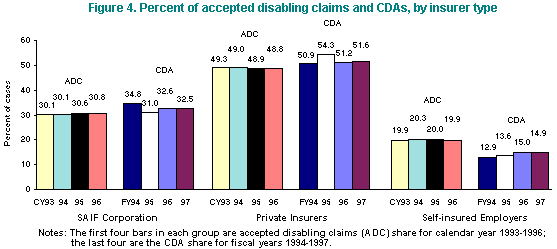
CDA Outcomes
Issues released. Of the approved CDAs, 99.8 percent
released all issues (except medical services), as compared to
99.7 percent last year. There were no cases with just one issue
released.
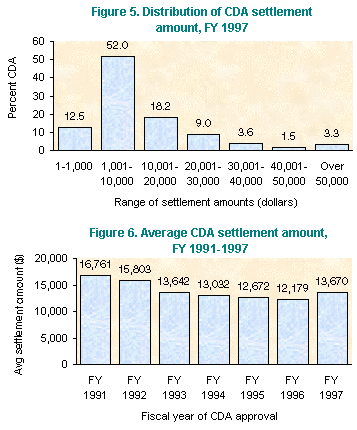 Settlement
amounts. The total settlement
amount (inclusive of attorney fees) for the approved cases was
$44.4 million for an average of $13,670, compared to $49.2 million
last year for an average of $12,179. Of this, fees for the claimants’
attorneys were authorized up to $6.1 million in 2,893 cases for
an average of $2,122 per case, compared to $7.5 million in 3,660
cases last year for an average of $2,043 per case. The maximum
attorney fees permitted by the board rules were awarded in 83.2
percent of the 2893 cases with fees; 16.7 percent had less than
the maximum and 0.1 percent had extraordinary fees. Over half
(52.0 percent) of the settlement amounts this year were over
$1,000 but less than or equal to $10,000; 95.3 percent were $40,000
or less. (See Figure 5.) Forty-two cases (0.6 percent) had a
settlement amount of over $100,000. The average settlement amount
decreased steadily from FY 1991, the first year CDAs were authorized
through FY 1996. This trend was reversed in FY 1997 (Figure 6).
When cases were grouped according to various claim characteristics,
the average settlement amount varied, sometimes considerably.
See Table 1.
Settlement
amounts. The total settlement
amount (inclusive of attorney fees) for the approved cases was
$44.4 million for an average of $13,670, compared to $49.2 million
last year for an average of $12,179. Of this, fees for the claimants’
attorneys were authorized up to $6.1 million in 2,893 cases for
an average of $2,122 per case, compared to $7.5 million in 3,660
cases last year for an average of $2,043 per case. The maximum
attorney fees permitted by the board rules were awarded in 83.2
percent of the 2893 cases with fees; 16.7 percent had less than
the maximum and 0.1 percent had extraordinary fees. Over half
(52.0 percent) of the settlement amounts this year were over
$1,000 but less than or equal to $10,000; 95.3 percent were $40,000
or less. (See Figure 5.) Forty-two cases (0.6 percent) had a
settlement amount of over $100,000. The average settlement amount
decreased steadily from FY 1991, the first year CDAs were authorized
through FY 1996. This trend was reversed in FY 1997 (Figure 6).
When cases were grouped according to various claim characteristics,
the average settlement amount varied, sometimes considerably.
See Table 1.
The largest variation was seen in the different benefit types. The average for TTD was the lowest at $5,192, while the settlement amounts for fatalities and PTDs averaged $167,205 and $147,508 respectively.
For disabling claims, the average settlement was $14,624, over $10,600 more than that for non-disabling claims. For claims involving injury to scheduled body parts, the average was $11,339, about $3,320 less than that for unscheduled body parts (back and other). Claims without a history of litigation were settled for an average of $15,159, $2,100 more than for litigated cases.
Looking at the settlement amounts by insurer type, self-insured employers had the lowest average with $12,240; SAIF averaged $13,127. Private carriers had the highest average with $14,498. SAIF’s average would go down by $98 if the non-complying employer cases (which SAIF handles) are also added to their count.
Type of settlement. Almost all of the CDAs (99.4%) were settled by a lump sum payment, nearly the same as last year; the rest were by structured settlement.
Reimbursements from departmental reserves. Claims of some claimants qualify for reimbursement of compensation (partially or fully) from departmental reserves. CDA settlements may also qualify for reimbursement in these cases. Insurers were reimbursed for CDA payments in CDAs approved by the board in FY 1997 as follows: two claims from the Handicapped Workers’ Reserve for $66,742, twenty-five from the Retroactive Reserve for $2,063,129 and twenty-six from the Reemployment Assistance Reserve for $320,500.
CDAs and disputed claim settlements (DCSs). Of the CDAs approved in FY 1997, 1,137 (35 percent) had some denied issue associated with the same injury or illness settled by a DCS between one and 120 days before the CDA approval. The average CDA settlement amount in these cases was $9,876, less than that for all CDAs by 27.8 percent.
Time lags. In the CDAs that were approved by the board, the median time lag between the request and the order was seven days, same as last year; 99 percent were approved within 48 days of the request. The dramatic reduction of the request to order lag since FY 1995 was due to the waiving of the 30-day cooling-off period where the claimant was represented by an attorney. The median time lag from injury to order was 693 days (1.9 years).
Trends. Fiscal year 1997 is the seventh year since CDAs were first introduced. CDA characteristics that have shown noticeable trends are graphed in Figures 6-10. The mean settlement amount which was $16,761 in FY 1991 decreased steadily through FY 1996; this trend was reversed in FY 1997 (Figure 6).
 There has been a consistent increase
in the percent of open cases disposed of by CDA (Figure 7), rising
steadily from 16.3 percent in FY91 to 32.2 in FY97, and the median
time lag between injury and CDA approval has shown a distinct
downward trend (Figure 8). The average age of claimants in claims
settled by a CDA has stayed close to 42 years during the last
three years (Figure 9).
There has been a consistent increase
in the percent of open cases disposed of by CDA (Figure 7), rising
steadily from 16.3 percent in FY91 to 32.2 in FY97, and the median
time lag between injury and CDA approval has shown a distinct
downward trend (Figure 8). The average age of claimants in claims
settled by a CDA has stayed close to 42 years during the last
three years (Figure 9). As far as benefit types are concerned,
the only noticeable trend is in PPD; the percent of cases with
PPD awards disposed of by a CDA shows a decreasing trend (Figure
10). Even though no particular trend is seen in TTD cases, they
showed a slight but steady increase in FY 1995 and FY 1996, but
dropped in FY 1997.
As far as benefit types are concerned,
the only noticeable trend is in PPD; the percent of cases with
PPD awards disposed of by a CDA shows a decreasing trend (Figure
10). Even though no particular trend is seen in TTD cases, they
showed a slight but steady increase in FY 1995 and FY 1996, but
dropped in FY 1997.